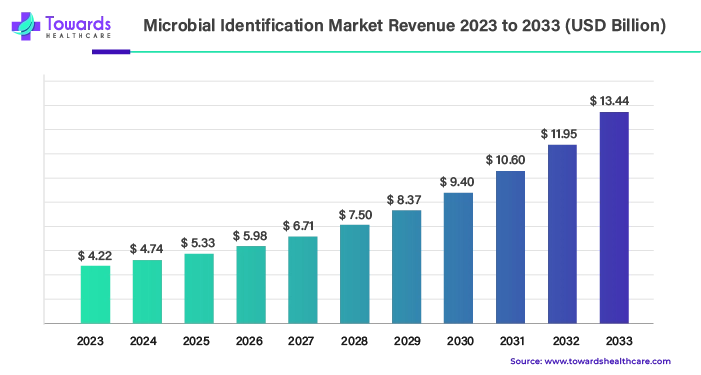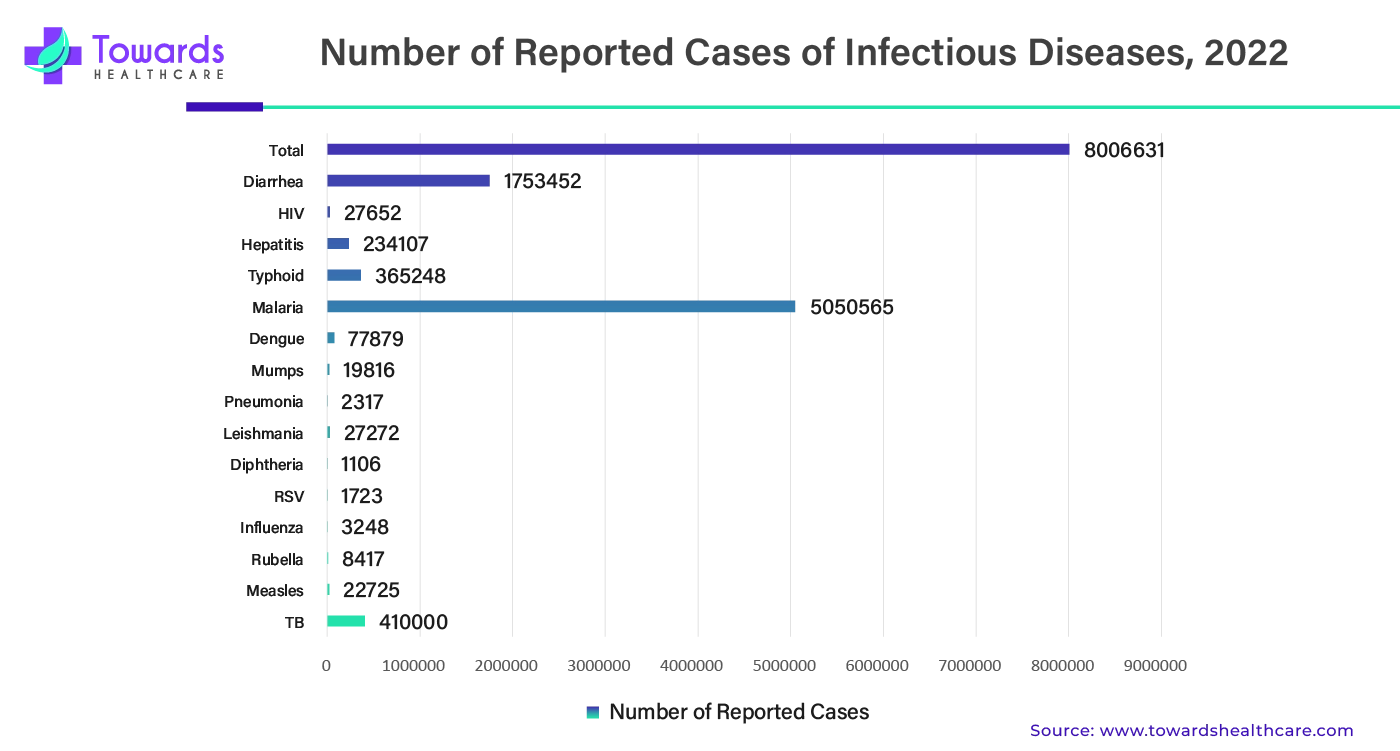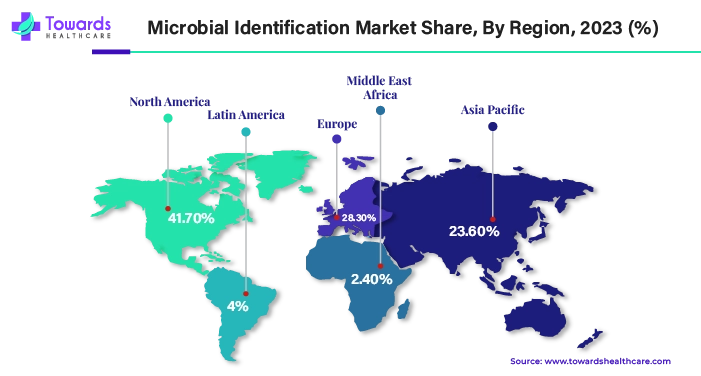April 2025

The global microbial identification market size was estimated at US$ 4.22 billion in 2023 and is projected to grow to US$ 13.44 billion by 2033, rising at a compound annual growth rate (CAGR) of 12.30% from 2024 to 2033. The market for microbial identification is expected to rise as a result of a number of factors, including the rising incidence of infectious diseases, technical developments, an increase in R&D activity, and rising government spending in the biotechnology and life science industries.

The industry that includes the tools, goods, and services needed for precise and quick microbe identification is known as the microbial identification market. For inquiries into deviations from specifications, such as those arising from dosage audits, sterility testing, bioburden testing, bacterial endotoxin testing (LAL), and biological indicator testing, microbial identification offers supplementary data. For scientists working in a variety of practical research and industrial fields, from food production to clinical microbiology, accurately identifying bacteria is crucial.
From 2025 to 2030 the market is expected to expand at a robust CAGR of 12.30%, rising from an estimated value of approximately US$ 5.33 billion in 2025 to around US$ 9.40 billion by 2030. This growth trajectory reflects the increasing demand for accurate and efficient microbial identification solutions, supported by substantial government investments in biotechnology and life sciences.
Artificial intelligence (AI) has significantly changed microbiological diagnostics with its quick and accurate analysis. Microbial colony counts can be automated with the use of artificial intelligence (AI), which reduces mistakes and saves time in the lab. In addition, artificial intelligence-powered systems are able to determine an individual's susceptibility to antibiotics, which helps clinicians customize treatments. By analyzing genetic data and identifying patterns that suggest virulence or antibiotic resistance, AI also helps in the diagnosis of microbial diseases. More targeted treatments can now be used as a result.
For instance,
| Company Name | Biolog Inc. |
| Headquarters | California, U.S., North America |
| Recent Development | In June 2024, a pioneer in cell-based microbial identification and phenotypic and metabolic profiling products and services, Biolog, Inc., recently announced the introduction of its new PreBioMTM microplate product line for organism selection and microbiome analysis. With the use of these microplates, researchers may analyze and create novel probiotics while also gaining a deeper understanding of the behavior and interactions of specific microorganisms and communities that are commonly seen in the gut microbiome. |
| Company Name | bioMérieux SA |
| Headquarters | France, Europe |
| Recent Development | In February 2024, bioMérieux, a global leader in in vitro diagnostics for 60 years, has partnered strategically with the US Food and Drug Administration (FDA), the Center for Food Safety and Applied Nutrition (CFSAN), the Offices of Applied Research and Safety Assessment (OARSA), and Regulatory Science (ORS) to develop tools to combat food-borne pathogens. The agreement will open the door for numerous creative studies aimed at enhancing microbial characterization and detection technologies for infections that could be dangerous to food. |
It takes both direct and indirect methods to identify the agent in the complex process of diagnosing infectious diseases. Correct disease diagnosis, effective infection treatment, and the ability to track down disease outbreaks linked to microbial infections all depend on precise and conclusive microorganism identification, including pathogen and bacterial identification.
Moreover, more than 52 million (33%) deaths globally each year are attributed to infectious diseases, which continue to rank among the world's top causes of morbidity and mortality.

One major obstacle for many labs and organizations wishing to invest in cutting-edge microbiology technology is the high cost of automated microbial identification systems. These systems have many advantages, such as improved data analytic capabilities, decreased manual labor, and quick and precise microbiological identification. Nevertheless, adoption is frequently hampered by their high cost. The complex technology that automated microbial identification systems use is one of the main causes of their high cost.
As a result of technological advancement, sophisticated methods now fully replace traditional methods for microbiological identification. In spite of this, a large number of environmental microorganisms remain unidentified and lack a proper nomenclature. Automation, software development, and the aggregation of many databases will make more data accessible in the future and lead to the discovery of more novel species of microbes.
The consumables segment held the largest share of the microbial identification market in 2023. Consumables for laboratories are essential pieces of equipment. Petri dishes, test tubes, glassware, beakers, pipette tips, and other items are among the necessary labware. Scientific research and innovation have advanced since laboratory consumable products have proven to be effective. Scientific advancement has been completely transformed by laboratory products, which give researchers the instruments they need to conduct their investigations.
For instance,
The software & services segment is anticipated to grow at the fastest CAGR in the microbial identification market during the forecast period. A straightforward and effective conditional probability model forms the basis of the software. Data on sequences is gathered, examined, and contrasted down to the species level using software. Any microorganism that is listed in an accessible database can be identified using the program. Also, it has the ability to quickly analyze offline interactive dichotomous trees.
The PCR segment held the dominant share of the microbial identification market in 2023. Nowadays, real-time PCR, also known as quantitative PCR or qPCR, is a widely accepted technique for the identification, measurement, and characterization of many microbiological agents in the fields of food safety and veterinary and clinical diagnostics. When it comes to quickly identifying microbial pathogens in clinical specimens, PCR is the most sensitive technique currently available.
For instance,
The next-generation sequencing segment is estimated to grow at the fastest rate in the microbial identification market during the forecast period. The varied microbiome makes it difficult to accurately identify the primary bacteria in foot infections. False-positive or false-negative growth in a conventional culture could result in inadequate antibiotic therapy following surgery. In orthopedic infections, next-generation sequencing (NGS) has been investigated as a possible substitute for conventional culture. The highly sensitive NGS technology can find the whole bacterial genome and genes granting antibiotic resistance in a sample.
The genotypic segment dominated the microbial identification market in 2023 and is expected to grow at the fastest rate during 2024-2033. Genetic analysis using nucleic acid probes or other molecular techniques is the final technique used to identify microorganisms. It is common practice to employ molecular methods to identify and detect infections. Genotypic techniques have made it possible to characterize uncultivable bacteria, identify a wide variety of hitherto unknown taxa, and conduct metagenomics research on sizable and varied bacterial communities.
The clinical diagnostics segment dominated the microbial identification market in 2023. The need for more thorough, clinically useful information on pathogenic bacteria in a shorter amount of time is driving a rapid evolution of the diagnostic microbiology laboratory. Medical microbiologists will need to steer this shift to make sure that testing supports the best patient care decisions at their organizations, as molecular methods for organism detection and characterization are about to expand and shift the focus of laboratories from culture-based to genomic-based analysis.
The pharmaceuticals segment is anticipated to grow at the fastest rate in the microbial identification market during the forecast period. A quality assurance program must include microbial identification, particularly in relation to environmental monitoring (EM), bioburden assessments for raw materials and finished products, and investigations into out-of-specification (OOS) cases. Microbial identification contributes to better pharmacy operations and gives us a better understanding of compounding settings.
The hospitals & diagnostic laboratories segment held the largest share of the microbial identification market in 2023. As end-users, hospitals and diagnostic labs are propelling the growth of the microbiological identification market. The demand for microbial identification technologies in these settings is being driven by the rising prevalence of infectious diseases and the requirement for precise and prompt identification of microorganisms. It is anticipated that in the upcoming years, this tendency will keep driving market expansion.
The pharmaceutical & biotechnology companies segment is estimated to grow at the fastest rate in the microbial identification market during the predicted period. As end-users, pharmaceutical and biotechnology labs are a major factor in the market expansion for microbial identification. The use of microbial identification technologies in these contexts is being driven by the growing emphasis on research and development activities as well as the growing demand for efficient microbiological testing and identification solutions. It is anticipated that this tendency will further propel market expansion in the biotechnology and pharmaceutical industries.

North America dominated the microbial identification market by 41.70% in 2023. The healthcare infrastructure in North America, especially in the US and Canada, is highly developed and allows for the widespread application of microbial identification technology for hospital infection control and clinical diagnostics. Due to the high prevalence of infectious diseases in the area, prompt and precise microbiological diagnosis is becoming increasingly important for the appropriate management and treatment of these illnesses. Furthermore, stringent regulations pertaining to food safety, pharmaceuticals, and environmental monitoring mandate thorough and efficient testing, which in turn impacts regional trends in the microbial identification sector. Aside from this, major companies in the North American market are concentrating on broadening their horizons through joint ventures, partnerships, and the establishment of new research facilities.
For instance,
Asia Pacific is expected to grow at the fastest rate during the forecast period. The increasing prevalence of infectious diseases and the economic growth of countries like China and India have led to a surge in investments in biotechnology and pharmaceutical companies, as well as in healthcare and other industries. This has aided in the growth of the market and the sector for microbiological identification solutions. Furthermore, the market in China commanded the most market share, while the microbial identification market in India grew at the fastest rate in the Asia-Pacific area.
Over the past ten years, China's biotech industry has experienced remarkable growth. The agricultural biotech market in China is believed to be worth $8.1 billion, while the biologics market in the United States is estimated to be worth $118 billion and $110 billion, respectively. The biologics market in China is valued at 30 to 40 billion yuan ($4.7 to $6.2 billion).
By utilizing the power of strategic alliances and developing national capacity, the Indian government is leading the way in fostering biotechnology innovation and entrepreneurship. One hundred fifty firms have raised around INR 4,500 Cr in follow-on funding. The nation's bioeconomy is projected to grow from $137 billion in 2023 to $300 billion by 2030.
| Investment Opportunities in Hospital/Medical Infrastructure in India | |
| Sector | Investment Opportunities (IIG) |
| Medical Infrastructure | 582 Opportunities worth US$ 32.16 Billion |
| Pharma, Biotech & Lifesciences | 81 Opportunities worth US$ 362.37 Million |
By Product & Services
By Technology
By Method
By Application
By End-use
By Region
Clinical trials are studies that test new medical treatments, drugs, or devices in humans to ensure they are safe and effective. These trials are crucial for medical advancements and involve pharmaceutical companies, research institutions, and healthcare providers.
Governments are actively supporting the growth of the clinical trials market by investing in better data collection, scientific infrastructure, and intellectual property protections. They are also improving regulations to make the approval process for new treatments faster and more efficient. This support helps to encourage innovation and attract investment in the clinical trials industry.
April 2025
December 2024
December 2024
December 2024